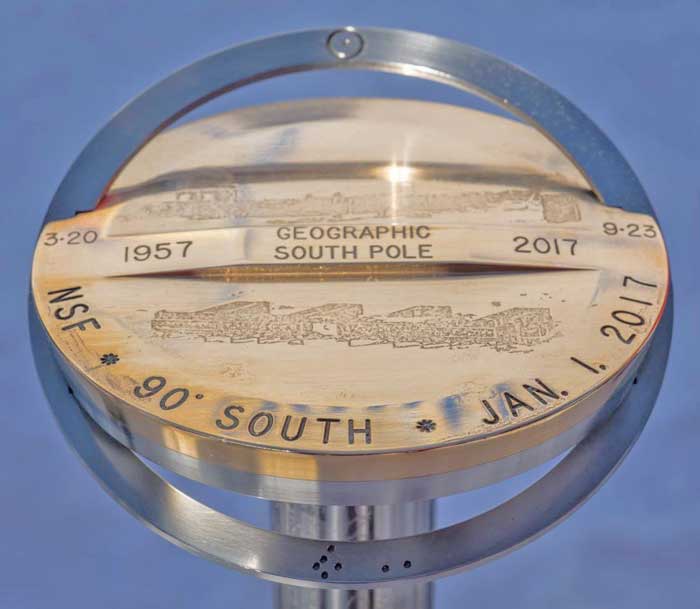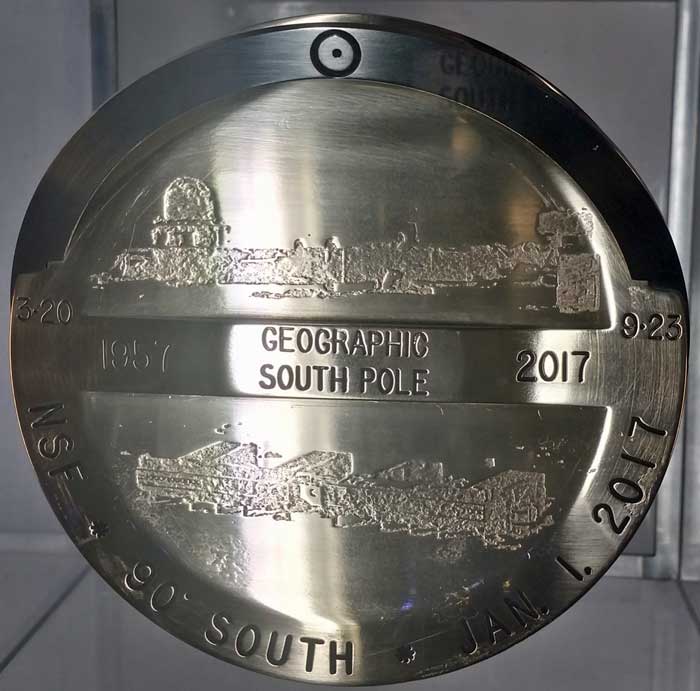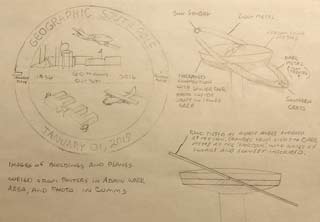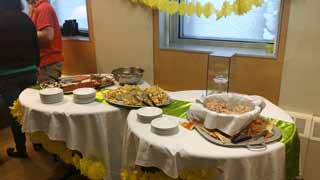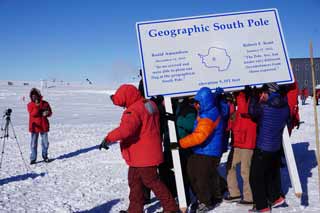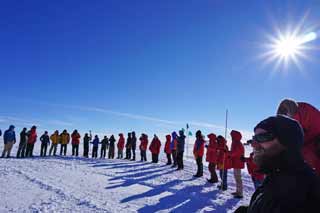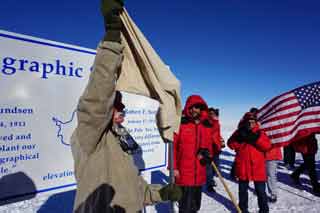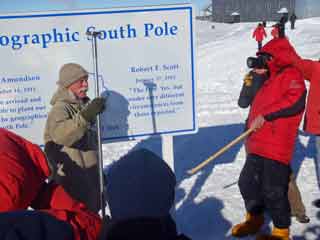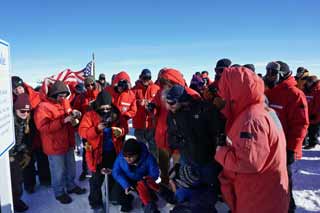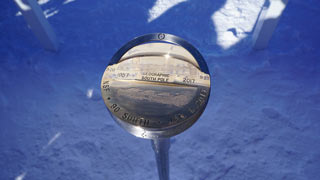The 2017 Pole Marker
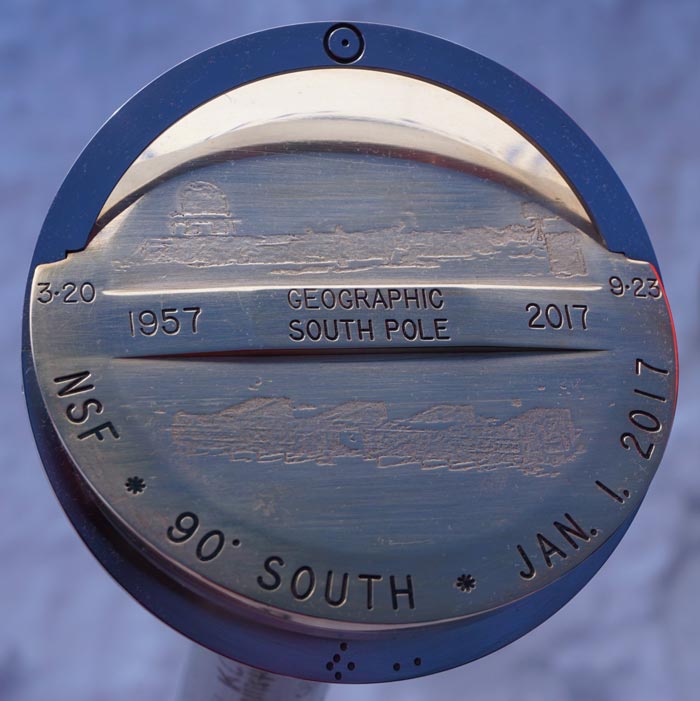 The marker unveiled 1 January 2017...yet another novel concept...detailed engraving and an ecliptic (GdW)! Since this was first posted, I heard from designer Warren Shipley, who provided lots of details and photos about this marker. So before we have a look at the unveiling ceremony, which happened on the evening of 1 January 2017, let us take a look at the design process and some of Warren's commentary about the marker. I'll start with the above photo...I've overadjusted the lighting of this 1 January 2017 photo seen at bottom right on this page (MW) so that the lower ecliptic is clearly visible. Showing one bit of exquisite detail--the Southern Cross, and the two brightest stars from the adjacent constellation Centaurus, Alpha Centauri and Beta Centauri. These stars are known as the Southern Pointers...if one constructs a line centered between and perpendicular to these stars and visualizes a line extended from the long axis of the Southern Cross, where these lines intersect is the approximate location of the actual South Pole. In the heavens...and on this marker!! Awesome!! This photo from Warren clearly shows the acid etchings on the upper face of the marker, which denote the fact that October 2016 marked the 60th anniversary of Amundsen-Scott South Pole Station after Gus Shinn landed his C-47/DC-3 there in October 1956. The upper portion of the marker depicts the original IGY station constructed in 1956-57, while the lower etching depicts the current elevated station. So here is Warren Shipley's discussion about the design: Matt [Krahn] stated that this will be the 60th anniversary of flights to the pole, and a station at the pole, so that was an obvious design point, so I decided to have a split screen take on the design, half with an image of the plane and station silhouette from 1956, and the other half for 2016. That didn't take long to figure out, but getting the images took a while longer. I found posters of the first station and the planes in the admin corridor, and current photos of the station, Baslers and LC-130c in the comms room. The divider between the halves would have the date ranges. I thought the marker would look better with a slight domed shape, and a screw off top for a time capsule interior, but that was too difficult and time consuming for NSF's taste. So we nixed the time capsule idea. Matt came up with acid etching the images into the surface. I wanted a representation of the Sun's path which is the tilted ring, it is at the angle the Sun reaches at it's highest, and intersects the marker with the 2016 Sunset and Sunrise dates noted as our meteorologist confirmed, with the astronomical symbol for the Sun at the high peak, and the Southern Cross at the lowest point to symbolize the major astronomical entities seen from the south Pole. The ring was also designed as two different metals, bright shiny brass for the half representing sunlight, and darker steel representing the long night, the metals would transition at the 'horizon' and the dates for Sunset and Sunrise. Matt did the ring all in brass, but tried to darken it by annealing the bottom half, it didn't meet his standards so he buffed it out and we went with what we have now. Matt did a wonderful job, and I would stop in during my rounds to see how he was progressing. There was talk of NSF wanting to get back to simpler designs that more resembled official geographic markers so I took the clue and used that for the basic design and added to it.Next, a few photos from Warren. The marker was displayed at the luau-themed sunrise dinner. | |
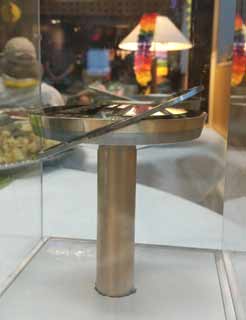 this side view clearly shows the tilted ecliptic. And a lei. |
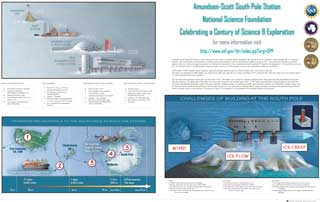 This poster, on display at Pole, was one of several used by Warren to develop the marker...in particular he used the graphic of the 1956 IGY station in the upper left image. This and the other posters are available from the "all illustrations" link on this NSF special report page. |
|
And here are the photos of the marker unveiling ceremony... | |
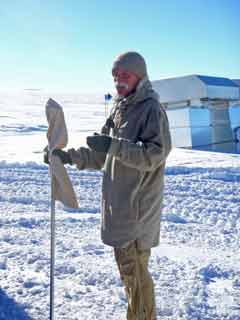 Here's winter site manager Wayne White about to unveil the marker (CH). |
|
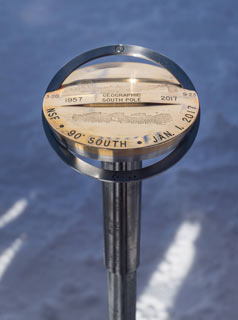 Another view which shows the multiple layers of metal...as well as the ecliptic extends below the horizon with the Southern Cross opposite the sun (look closely at the large photo). The winterovers' names/initials are inscribed on the lower post (MW). | |
|
The marker was designed by fire tech Warren Shipley...and created by machinist Matthew Krahn. They both did an amazing job! Credits and thanks: GdW is IceCuber Gwenhäel de Wasseige from the Interuniversity Institute for High Energy Physics in Brussels, she shared her photos on Twitter; CH is UT Chris Hawkins; DW is David Wolf; and MW is IceCube winterover Martin Wolf. And of course thanks to Warren Shipley as well. | |
